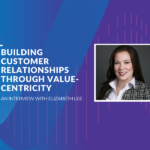Align Your Processes And Teams Around Your Customer
The most successful business leaders understand that customers are their business’ greatest asset, in theory. However, many of today’s most renowned leaders are still making the costly mistake of creating the customer journey map from an internal task-oriented perspective, making assumptions about customers’ wants and needs.
If this hits close to home, your organization may be at risk of being swallowed up by inefficient tasks that don’t drive customer value and sequestered teams that result in a disjointed customer experience.
The good news is, there’s still time to pivot your organization to a customer and value-first approach. In this article, we reveal the central components of a successful cross-company customer journey workshop that forms the basis of an effective and efficient organizational structure and aligns your team around expanding customer value delivery while empowering everyone to drive the greatest impact with your customers.
Make A Journey Map From Your Customer’s POV
A customer journey map is a customer’s complete experience with your organization that encompasses all customer interactions and touchpoints across the entire customer lifecycle, from acquisition to expansion. It’s an invaluable document that forms the basis of your organizational structure and resource allocation plan. However, some business leaders make the mistake of creating their customer journey map based on their perspective / point of view and in silos, thereby making assumptions about what their customers need and want. In doing so, these leaders are encumbered with inefficient tasks that don’t drive customer value and segregated / sequestered teams that result in a disjointed customer experience.
Instead, we recommend taking a step back from your own internal processes and embodying your customer through an organization-wide customer journey mapping workshop. By better understanding your customers and using that knowledge as the foundation of your customer journey map, you’re ensuring a better customer experience, paving the way for your customers to successfully achieve their goals and positioning your company to drive unprecedented recurring revenue growth.
Bring Your Cross-Functional Teams Together For A Customer Journey Workshop
According to UXPressia, over 59% of organizations conducted workshops during their last journey mapping initiative (2020). The process of bringing cross-functional teams together to define and outline a customer journey map is becoming more prevalent. Organizations are beginning to recognize the immense value of constructing a comprehensive customer journey map that truly reflects your customer’s entire lifecycle, from acquisition through expansion, as well as all of their touchpoints with your business.
To garner the most extensive customer journey map, conduct a workshop session that is highly cross-functional. Your session needs to include representatives from Marketing, Sales, Customer Success (including Services, Support, Education and Delivery), Product, as well as departments like Documentation and even Finance. If you leave even one of these teams out of your workshop, you risk missing out on crucial milestones and moments of engagement, creating blindspots in your customer journey.
Break Down The Customer Journey And Rebuild It From The Customer’s Perspective
Take each segment of the customer’s experience and explore it from the customer’s perspective. There are a few pivotal moments in the customer journey that we recommend examining; the customer’s discovery and purchasing motion, onboarding process, the customer’s first 90 and 180 days, the customer’s first renewal and ongoing adoption and expansion milestones.
Promote customer empathy in your organization by putting every single one of your cross-functional representatives in the customer’s shoes at each of these stages and moments in a customer’s journey. Think about it solely from the customers’ perspective by roleplaying as the customer as you answer the following questions:
- What am I experiencing when I engage a sales person to buy this solution?
- Are there any roadblocks or communication issues that might make my experience negative and make me want to buy from someone else?
- After I purchase, how easy is it to get everything turned on and my people using the solution?
- What is my first 90 days like using this solution? What do I expect to happen?
Continue this exercise throughout the entire mapping process to examine each step from the customer’s POV.
Put Your Customer Journey Map Into Action
Your completed customer journey map is the foundation for building an efficient organizational structure and economical allocation of your capacity and resources. Each of the important touchpoints that you have identified in the customer journey can now be assigned specific tasks and teams to create a smooth and unified experience that drives the customer seamlessly from acquisition to expansion. In this way, we start from the optimal customer experience and back into the “how” by aligning tasks and teams later.
When assigning roles & responsibilities, consider the following questions to optimize your processes and teams:
- What actions do you need to undertake to ensure that the customer has an easy contract experience?
- Is your Sales motion clear? Are your contract line items aligned with the value that Sales prescribed and promised?
- When customers reach onboarding, does the product perform to meet their needs and goals? Can the product be improved to meet them more clearly at the beginning?
- Have you set expectations for how to access valuable documentation or other Customer Success resources?
- Do customers know who to reach out to if they have a problem? Is this a pleasant process for them?
The answers to these questions will determine where you allocate your company’s time, where you can streamline your processes through automation and which areas require fine tuning.
Map Your Way To Customer-Centricity
Customer journey mapping is an essential exercise to becoming a truly customer-centric organization. It gives your organization a crystal clear picture of your customers’ value-driving activities so that you can accurately assess your current processes and begin an organizational transformation that aligns your cross-functional teams around the shared goal of delivering greater value to your customers.
Customer-centricity is deeply rooted in value-centricity. Read our article about how to align your teams, tools and processes around customer value creation.





